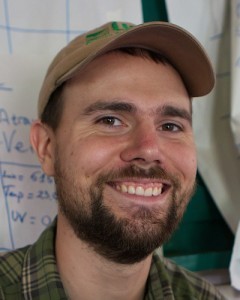Devin Edmonds, Mitsinjo, Andasibe, Madagascar
I saw my first Golden Mantella as a child for sale at a pet store in Madison, Wisconsin. I saved my allowance and returned to the store and bought it. Through adolescence, keeping amphibians became a defining feature of my identity, an urban misfit with few logs to turn or ponds to catch tadpoles in, but with dozens of terrariums and aquariums lining the walls of my bedroom, nature in glass boxes to observe under fluorescent lights. I turned my obscure hobby into a small business in college, breeding exotic frogs and selling them to private breeders and zoos. My parents’ basement became my own personal amphibian production facility. I had a business card and it had a frog on it.
Towards the end of my time at the university, I began volunteering at Henry Vilas Zoo. Hundreds of frogs had been evacuated from Panama after a disease outbreak, and part of the captive assurance colony was sent here. At the zoo there were shelves lined with terrariums, but inside were not frogs kept as commodities but instead the last of a population on the brink of extinction. I realized that my unusual set of amphibian husbandry skills could be applied to something more than just a hobby or business, but used also to assist declining wild populations of the species I was so fond of.
 |
| Having a Golden Mantella as a pet when he was a child, ultimately led Devin Edmonds to work with this and other amphibian species in their native country, Madagascar. |
Around the same time I began travelling outside the US to see my favorite amphibians in nature. With earnings from selling home-grown frogs out of my parents’ basement and the proceeds from writing a book about pet amphibians, I bought airplane tickets and applied for visas. I was vaccinated for strange diseases. I spent days in dugout canoes and got lost more than once. I was bitten by ants, chased by hornets. I tumbled down mountains. I ate new foods and promptly evacuated them from my body. And I found lots and lots of frogs, which I began to realize were part of something much bigger than a transparent deli cup with a price tag on it.
In 2006 one of these trips led me to Madagascar. I wanted to see the Golden Mantella in situ, the frog that had started it all nearly a decade earlier. I walked down a misty road towards the village of Andasibe, lemurs howling in rainforest nearby. Here I found a local guide. He belonged to an organization called Mitsinjo. They had an unofficial plan for starting a “frog breeding station”, something that had been proposed some months before I arrived. I told them I knew how to breed frogs. They said come back again and teach us how.
Four years later I did. By that point I had given away my personal exotic amphibian collection, and had worked to survey frogs in the Sierra Nevada. Watching frogs in terrariums was nice, but watching them in the field was even better. With the help of Jennifer Pramuk of Woodland Park Zoo and the support of Amphibian Ark, I found funding to help Mitsinjo launch their conservation breeding station, which we officially opened through a contract with the Malagasy government in April 2011.
Though I never intended to stay in Madagascar, I found I enjoyed more than just the frogs. I am now fortunate enough to call this island home. Working with a team of more than a dozen Mitsinjo members, we maintain a captive assurance colony of the Golden Mantella from a population extirpated from a nearby forest due to mining activities. We also run frog surveys to monitor for population declines, conduct studies to learn how best to maintain poorly known species in captivity, screen wild frogs for diseases, and raise awareness of the importance of amphibians within our local community.
It feels good to look back and see that what started as an adolescent’s unusual hobby turned into something much more. I am hopeful that in another fifteen years I will be able to reflect upon where amphibians have led me since and say the same again.
Check out our other Amphibian Advocates!











